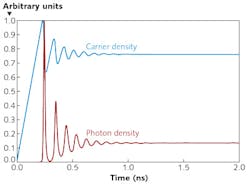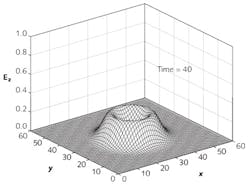Simulation and Modeling: Computational photonics models waveguide-based optics

MAREK S. WARTAK
Computational photonics is a branch of physics in which numerical methods are used to study properties and propagation of light in waveguiding structures (here, "light" is used in a broad sense as a replacement term for electromagnetic waves). Within this field, an important part is played by studies of the behavior of light and light-matter interactions using analytical and computational models. This emerging field of computational science is playing a critically important role in designing new generations of integrated-optics modules and long-haul transmission and telecommunication systems.
Generally, computational photonics is understood as a replacement of the experimental method in which one is performing all the relevant "experiments" on a computer. Clearly, such an approach reduces development costs and speeds up development of new products.
An important subtopic in photonics is integrated photonics, where the concentration is on waveguides, simulations of waveguide modes, and photonic structures.1 A central role is played here by the beam-propagation method.
At present, there is a significant critical mass of commercial software as well as public-domain programs, both of which are aimed at simulations of various photonic devices.
Commercially available photonics software
The following list represents our personal selections:
Optiwave provides comprehensive engineering design tools that benefit photonic, biophotonic, and system-design engineers with a comprehensive design environment.2 OptiBPM, which is based on the beam-propagation method (BPM), offers design of complex optical waveguides that perform guiding, coupling, switching, splitting, multiplexing, and demultiplexing of optical signals in photonic devices. OptiFDTD is based on the finite-difference time-domain (FDTD) algorithm with second-order numerical accuracy and the most advanced boundary condition, namely uniaxial, perfectly matched layers. Solutions for both electric and magnetic fields in temporal and spatial domain are obtained using the full-vector differential form of Maxwell's equations. OptiFiber uses numerical mode solvers and other models specialized to fibers for calculating dispersion, losses, birefringence, and polarization-mode dispersion (PMD). OptiGrating uses the coupled-mode theory to model light and enable analysis and synthesis of gratings.
The RSoft product family includes a component-design suite to allow analysis of complex photonic devices and components through computer-aided design; system simulation to determine the performance of optical telecom and datacom links through comprehensive simulation techniques and component models; and network modeling for cost-effective deployment of dense wavelength-division multiplexing (DWDM) and synchronous optical network (SONET) technologies while designing and optimizing an optical network.3
Photon Design offers several products for both passive and active component design, including FIMMWAVE and CrystalWave.4 FIMMWAVE is a generic, full-vectorial mode finder for waveguide structures that combines methods based on semianalytical techniques with other more-numerical methods such as finite difference or finite element. FIMMWAVE comes with a range of visual tools for designing waveguides, each optimized for a different geometry: rectangular geometries often encountered in epitaxially grown integrated optics, circular geometries for the design of fiber waveguides, and more-general geometries to cover, for example, diffused waveguides or other unusual structures. CrystalWave is a design environment for the layout and design of integrated-optics components optimized for the design of photonic-crystal structures. It is based on both FDTD and finite-element frequency-domain (FEFD) simulators and includes a mask-file generator optimized for planar photonic crystal structures.
VPIphotonics provides simulation software supporting requirements of active/passive integrated photonics and fiber-optics applications, optical transmission system and network applications, and cost-optimized equipment configuration.5
Much other simulation software exists, mostly oriented towards the design of optical devices. A recent article reports on some relevant software packages.6 Optical-design software is used by engineers and scientists to perform a variety of tasks, including illumination calculations, laser-beam propagation, stray-light analysis, and freeform optical design. Such software enables accurate and rapid virtual prototyping, allowing the performance of optical systems to be predicted and analyzed prior to fabrication. A number of websites are devoted to photonics software and numerical modeling in photonics. We mention the following website entitled Optical Waveguides: Numerical Modeling.7
Two computational platforms: MATLAB and Octave
A special role in computational photonics in recent years has been played by the MATLAB and Octave computational platforms.
MATLAB (matrix laboratory) is a multi-paradigm numerical computing environment and fourth-generation programming language.8 A proprietary programming language developed by MathWorks, MATLAB allows matrix manipulations, plotting of functions and data, implementation of algorithms, creation of user interfaces, and interfacing with programs written in other languages, including C, C++, Java, Fortran, and Python.
GNU Octave is software based on a high-level programming language and is primarily intended for numerical computations.9 It provides a command-line interface for solving linear and nonlinear problems numerically, and for performing other numerical experiments using a language that is mostly compatible with MATLAB. It may also be used as a batch-oriented language. It is part of the GNU Project, so it is free software under the terms of the GNU General Public License. Octave is the major open-source alternative to MATLAB and is almost 100% compatible with it.
MATLAB tools available for photonics simulations
The website MATLAB Central is an excellent resource for anyone looking for photonics-simulation software.10 MATLAB toolboxes for optics and photonics simulations listed there include:
Interactive Simulation Toolbox for Optics. Based on the FDTD method, this software is aimed at simulations of two-dimensional optical systems. The Yee FDTD algorithm has been implemented—the user inputs parameters using a graphical user interface (GUI).
Optical Waveguide mode solver. This implementation, which is based on the semivectorial finite-difference method, was developed for finding the eigenmodes of various waveguides.
Semiconductor optical amplifier model. This simulates gain and spontaneous emission in semiconductor optical amplifiers (SOAs)—all details are also provided in a book.11
Optical Fiber Toolbox. This allows for fast automatic calculations of guided modes in optical fibers and finds solutions for weak and strong guiding.
Phase-based Optical Flow. This code implements a new technique for estimating the optical flow field starting from image sequences.12
Recent books devoted to photonics simulations
Salah Obayya, Computational Photonics, Wiley (2011). "In this book, the author provides a comprehensive coverage of modern numerical modeling techniques for designing photonic devices for use in modern optical telecommunications systems. In addition, the book presents the state-of-the-art in computational photonics techniques, covering methods such as full-vectorial finite-element beam propagation, bidirectional beam propagation, complex-envelope alternative direction implicit finite difference time domain, multiresolution time domain, and finite volume time domain. The book guides the reader through the concepts of modeling, analyzing, designing, and optimizing the performance of a wide range of photonic devices by building their own numerical code using these methods."
Slawomir Sujecki, Photonics Modelling and Design, CRC Press (2015). "The intention of this book is to introduce an engineer or applied physicist to the modeling and design of photonic devices. This book was written on the basis of both teaching and research carried out by the author. It is therefore written in such a way that it contains material suitable for both undergraduate and master's students, but is also of benefit to PhD students and researchers interested in the modeling and design of photonic devices. The author has tried to avoid using specialized mathematical and quantum mechanical language to make this book approachable to a wider audience. Further, the book contains a strong 'hands-on' element that is backed up by several, relatively simple illustrative examples of software developed within the MATLAB environment."
Marek S. Wartak, Computational Photonics, Cambridge University Press (2013). This book presents itself as a comprehensive manual on the efficient modeling and analysis of photonic devices. It is aimed at graduate students and researchers who are expected to have the theoretical background and MATLAB programs necessary for them to start their own numerical experiments. The author introduces the physics required to enable students to gain an understanding of photonics. The underlying philosophy is that conducting numerical experiments will deepen a student's understanding of the material. The amalgam of text and MATLAB programs provides the reader with a unique combination of photonics principles and simulation software. The book covers new topics like metamaterials, as well as staples such as optical waveguides and semiconductor lasers. The book's content has been "road-tested" at a number of universities in Europe and North America, and is the result of the author's 25 years of experience in the field. The book will be most useful to emerging photonics experts who have access to the necessary computer programs.
Two MATLAB examples
Examples of simulations using MATLAB are shown in the two figures. Phenomenological description of semiconductor lasers is often done based on the rate-equations approach.13 The main role in those devices is played by two subsystems: carriers (electrons and holes) and photons. They interact in the so-called active region, defined as the part of the structure where recombining carriers contribute to useful gain and emission of photons. The dynamical processes there are described by rate equations that provide time evolution of photon and carrier densities. In Fig. 1, we show typical results of the numerical integration of large-signal analysis rate equations after applying a rectangular current pulse at time t = 0. Oscillations of both carrier and photon densities are observed. The frequency of these oscillations determines the rate at which energy is exchanged between photon system and carriers.In Fig. 2, we show the propagation of a Gaussian pulse at some time value. The pulse was initiated at a central point and travels outwards symmetrically from there. The pulse propagation is governed by discretized Maxwell equations carried out using a widely used numerical FDTD scheme for an approximate description of electromagnetic-wave propagation—a two-dimensional implementation (the Yee algorithm) without dissipation. The details of numerical discretization and the relevant MATLAB codes are provided in Wartak's book, p. 275.
REFERENCES
1. C. R. Pollock and M. Lipson, Integrated Photonics, Kluwer Academic Publishers, Boston, MA (2013).
2. See www.optiwave.com.
3. See https://optics.synopsys.com/rsoft.
4. See www.photond.com.
5. See www.vpiphotonics.com/index.php.
6. The Scott Partnership, "Optical simulation software," Nature Photon., 4, 256–257 (2010).
7. See http://optical-waveguides-modeling.net.
8. See www.mathworks.com/products/matlab.
9. See www.gnu.org/software/octave.
10. See http://bit.ly/1OpadwB.
11. M. J. Connelly, Semiconductor Optical Amplifiers, Kluwer Academic Publishers, Boston, MA (2002).
12. T. Gautama and M. M. Van Hulle, "A phase-based approach to the estimation of the optical flow field using spatial filtering," IEEE Trans. Neural Networks, 13, 5, 1127–1136 (2002).
13. L. A. Coldren, S. W. Corzine, and M. L. Mashanovitch, Diode Lasers and Photonic Integrated Circuits, 2nd Edition, Wiley, New York, NY (2012).
Marek S. Wartak is a professor and chair of the Department of Physics and Computer Science at Wilfrid Laurier University, Waterloo, ON, Canada; e-mail: [email protected]; www.wlu.ca.
